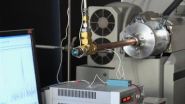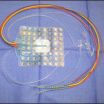(Press-News.org) The drug scopolamine has been used to treat a variety of conditions, including nausea and motion sickness. A new study by UCLA life scientists suggests that it may also be useful in treating anxiety disorders.
Researchers found that the drug can help boost the effectiveness of a common treatment for anxiety disorders known as exposure therapy. In exposure therapy, a subject with a phobia or anxiety is repeatedly exposed to the object or situation they fear, in a non-threatening setting. The goal of this treatment is to ultimately lessen and eliminate the fear — in essence, make it "extinct."
However, fear-extinction memories formed during this type of therapy tend to be weak because they are tied to the non-dangerous context. Subjects have a tendency to relapse when they again encounter the source of their anxiety in a different environment.
"Extinction has one Achilles heel that at present has not quite been pierced — namely, extinction learning is highly dependent on the environment or context in which it occurs," said Michael Fanselow, a UCLA professor of psychology and the senior author of the study. "This makes memories formed during extinction highly fragile and susceptible to fear-recovery or relapse in any non-extinction environment."
In their new study, published Feb. 15 in the in the journal Biological Psychiatry, Fanselow and his colleagues attempted to overcome this challenge by administering scopolamine in conjunction with the exposure therapy.
"We took an entirely novel theoretical approach by targeting extinctions' context-dependency and attempting to unbind extinction from its contextual bond," said Fanselow, who holds UCLA's Eleanor Leslie Term Chair in Innovative Neuroscience. "Using a non-invasive and readily translatable pharmacological agent, scopolamine, to block cholinergic transmission and hence, contextual processing, we discovered that fear-recovery after extinction could be thwarted."
Fanselow and his team were able to disrupt contextual processing in rats during anxiety-extinction by using low doses of the drug.
"This finding provides groundbreaking evidence that changing the nature of extinction learning, rather then its magnitude, can produce profound improvements in the prevention of relapse," Fanselow said.
The research, while still preliminary, suggests that scopolamine may be an effective pharmacological adjunct to exposure therapy.
###
The lead author of the study was Moriel Zelikowsky, who conducted the research as a UCLA graduate student in Fanselow's laboratory.
The research was federally funded by the National Institute of Mental Health, part of the National Institutes of Health.
UCLA is California's largest university, with an enrollment of more than 40,000 undergraduate and graduate students. The UCLA College of Letters and Science and the university's 11 professional schools feature renowned faculty and offer 337 degree programs and majors. UCLA is a national and international leader in the breadth and quality of its academic, research, health care, cultural, continuing education and athletic programs. Six alumni and six faculty have been awarded the Nobel Prize.
For more news, visit the UCLA Newsroom and follow us on Twitter.
UCLA life scientists identify drug that could aid treatment of anxiety disorders
2013-02-21
ELSE PRESS RELEASES FROM THIS DATE:
Explosives vapor detection technology: The new 'sniff test'
2013-02-21
RICHLAND, Wash. – A quick, accurate and highly sensitive process to reliably detect minute traces of explosives on luggage, cargo or travelling passengers has been demonstrated by scientists at the Department of Energy's Pacific Northwest National Laboratory. The vapor detection technology accurately detects and identifies the vapors of even very low-volatility explosives in real time at ambient temperature and without sample pre-concentration. Details are outlined in a recent issue of Analytical Chemistry.
Rather than searching for particle residue using a typical method ...
Science synthesis to help guide land management of nation's forests
2013-02-21
ALBANY, Calif.—A team of more than a dozen scientists from the U.S. Forest Service's Pacific Southwest (PSW) and Pacific Northwest research stations, universities and Region 5 Ecology Program recently released a synthesis of relevant science that will help inform forest managers as they revise plans for the national forests in the Sierra Nevada and southern Cascades of California. The three most southern national forests in the Sierra Nevada—Inyo, Sequoia and Sierra—will be among the first of the 155 national forests to update their management plans. The new planning rule ...
Cooling may prevent trauma-induced epilepsy
2013-02-21
In the weeks, months and years after a severe head injury, patients often experience epileptic seizures that are difficult to control. A new study in rats suggests that gently cooling the brain after injury may prevent these seizures.
"Traumatic head injury is the leading cause of acquired epilepsy in young adults, and in many cases the seizures can't be controlled with medication," says senior author Matthew Smyth, MD, associate professor of neurological surgery and of pediatrics at Washington University School of Medicine in St. Louis. "If we can confirm cooling's effectiveness ...
The brainless origin of our head
2013-02-21
In many animals, the brain is located in a specific structure, the head, together with sensory organs and often together with the mouth. However, there are even more distantly related animals, which have a nervous system, but no brain, like sea anemones and corals.
In this collaborative study between a research group led by Fabian Rentzsch (Sars Centre Bergen) and Ulrich Technau from the Dept. of Molecular Evolution and Development the sea anemone Nematostella vectensis was used to find out if one of the ends of the sea anemone corresponds to the head of higher animals. ...
Aspirin and omega-3 fatty acids work together to fight inflammation
2013-02-21
Experts tout the health benefits of low-dose aspirin and omega-3 fatty acids found in foods like flax seeds and salmon, but the detailed mechanisms involved in their effects are not fully known. Now researchers reporting in the February 21 issue of the Cell Press journal Chemistry & Biology show that aspirin helps trigger the production of molecules called resolvins that are naturally made by the body from omega-3 fatty acids. These resolvins shut off, or "resolve," the inflammation that underlies destructive conditions such as inflammatory lung disease, heart disease, ...
Why living against the clock is a risky business
2013-02-21
Living against the clock—working late-night shifts or eating at inappropriate times, for example—can come with real health risks, metabolic syndrome, obesity, and diabetes among them. Now, researchers reporting in Current Biology, a Cell Press publication, on February 21 have new evidence to explain why it matters not just what mice (or by extension, people) eat, but also when they eat it.
Insulin action rises and falls according to a 24-hour, circadian rhythm, the researchers found. What's more, mice unable to keep the time for one reason or another get stuck in an insulin-resistant ...
For monarchs to fly north, first they've got to chill
2013-02-21
Monarch butterflies are well known for their ability to fly 2,000 miles south from North America to Mexico each fall and back again in the spring. Now, researchers reporting in Current Biology, a Cell Press publication, on February 21 have evidence to show that the butterflies would just keep on heading south if it weren't for the chilly weather.
The findings help to explain why the butterflies spend the winter on frosty mountaintops. They also imply that global climate change could profoundly influence the monarchs' migrations, the researchers say.
"The monarchs need ...
Biomarker may identify neuroblastomas with sensitivity to BET bromodomain inhibitors
2013-02-21
PHILADELPHIA — Neuroblastoma, the most common malignant tumor of early childhood, is frequently associated with the presence of MYCN amplification, a genetic biomarker associated with poor prognosis. Researchers have determined that tumors containing MYCN amplification are sensitive to a new class of drugs, BET bromodomain inhibitors.
The researchers made this discovery in a preclinical study, which was funded in part by a Stand Up To Cancer Innovative Research Grant and was published in Cancer Discovery, a journal of the American Association for Cancer Research.
"BET ...
Life's tiniest architects pinpointed by Yale researchers
2013-02-21
If a genome is the blueprint for life, then the chief architects are tiny slices of genetic material that orchestrate how we are assembled and function, Yale School of Medicine researchers report Feb. 21 in the journal Developmental Cell.
The study pinpoints the molecular regulators of epigenetics – the process by which unchanging genes along our DNA are switched on and off at precisely right time and place.
"Our genome is like a landscape with lakes, mountains, and rivers, but it is not yet a community or a city full of buildings," said Haifan Lin, director of the ...
Research shows that coldness triggers northward flight in migrating monarch butterflies
2013-02-21
WORCESTER, MA – Each fall millions of monarch butterflies from across the eastern United States begin a southward migration in order to escape the frigid temperatures of their northern boundaries, traveling up to 2,000 miles to an overwintering site in a specific grove of fir trees in central Mexico. Surprisingly, a new study by scientists at the University of Massachusetts Medical School published in Current Biology, suggests that exposure to coldness found in the microenvironment of the monarch's overwintering site triggers their return north every spring. Without this ...




